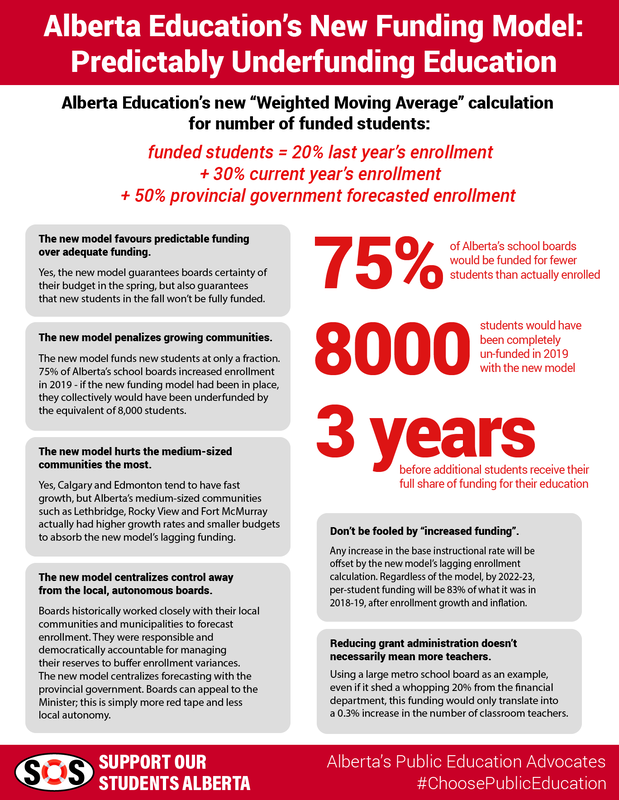|
On Tuesday February 18, 2020, Minister Adriana LaGrange announced a new K-12 funding model. The new model made two significant changes: consolidating multiple, targeted grants into fewer, more generalized grants; and changing how and when student enrollment is calculated and how school board budgets subsequently finalized. In a news conference notably devoid of specifics, LaGrange was nonetheless undeterred in making three bold claims about this new model:
Claim #1: New Funding Model will drive more funds towards school boardsCurrent Funding Model: In the current model, school boards are required to submit their upcoming budget yearly by June 30. As funding is calculated per student, board budgets must estimate student enrollment, with actual enrollment numbers not known until September 30. Of course, actual enrollment inevitably varies from the estimate, and thus, funding is adjusted in the fall to match actual enrollment. Ultimately, each student was both accounted for and funded. Variances were handled through board reserve funds, which each board independently managed. New Funding Model (Weighted Moving Average Model) In the new funding model, rather than fund boards based on actual enrollment numbers as measured in the fall, a LaGrange introduced a new “Weighted Moving Average” (WMA) formula to determine enrollment when budgets are submitted in the spring. The budgets are not subsequently adjusted with actual enrollment numbers. This WMA formula, calculates the number of funded students to be the sum of:
SAMPLE CALCULATION: To see how this formula underfunds a growing school board, let’s assume a 3% year over year population growth for a sample calculation: Funding = 0.2a + 0.3b + 0.5c Where a = 2018 enrollment b = 2019 enrollment c = 2020 forecasted enrolment Assuming enrollment increases ( 3% growth year over year) Then: 2020 enrollment = 1.03 (2019 enrollment) 2019 enrollment = 1.03 (2018 enrollment) Using the variables above this means: c = 1.03b b = 1.03a then c = 1.03(1.03) a c=1.032a OR a = c/(1.03)2 This now allows us to use the MWA Funding Formula to simplify terms: FF = 0.2a + 0.3b +0.5c FF= 0.2a +0.3(1.03)a +0.5(1.03)2a FF = 0.2a + 0.309a+0.53a FF =1.039a But a represents the first year, we want c the current year. Recall c=1.032a so then a=c1.032 FF= 1.039c1.032 FF = 0.98 c This means, if the student population increases at 3%, the weighted average funding model will provide funding for only 98% of the enrollment. The claim that this new funding formula will allow for MORE dollars will somehow make it to classrooms for any division that sees an increase in population is FALSE. Claim #2: This model provides school boards with predictable fundingThe truth is, this model prioritizes predictability of funding, over adequate funding. LaGrange insists that knowing a firm budget in March is more valuable than funding every single student enrolled and accounted for at the end of September. The new model is predictable, in that for growing boards, the model will predictably underfund students. The reality of education funding is that the exact school population (# of students) is always variable and unknown until the year starts, and nothing can make this uncertainty go away. Existing Model
Claim #3: Reduction of Red Tape & Greater Autonomy for School BoardsRed Tape Reduction: While LaGrange introduced a reduction in grants (from 36 -15), as evidence of a reduction in red tape, she also indicated there will be a mechanism for boards to appeal and negotiate budgets if their enrolment forecasts are different than actual numbers. This is akin to creating a new grant, but with no defined parameters, criteria, or process transparency, and puts the onus on school boards to approach the ministry for adequate funding. Greater Autonomy for School Boards This claim is a stretch as the new formula actually centralizes the budget process, which used to lie in the hands of school boards. For example, with the existing model:
SummaryThe three main claims made by this government are demonstrably false.
Comments are closed.
|
Archives
April 2021
Categories |
|
Support Our Students Alberta is a non-partisan public education advocacy organization with chapters across Alberta. We are run by passionate volunteers and community donations.
Media and press comment requests: [email protected] SOS acknowledges that we advocate in Treaties 6, 7 & 8, traditional territory of the Cree, Blackfoot, Metis, Nakota Sioux, Iroquois, Dene and Ojibway/Saulteaux/Anishinaabe. We are grateful to work on their land and we pledge that this organization will actively work to end systemic racism and pursue truth and reconciliation. © 2023 Support our Students Alberta Foundation
|


 RSS Feed
RSS Feed